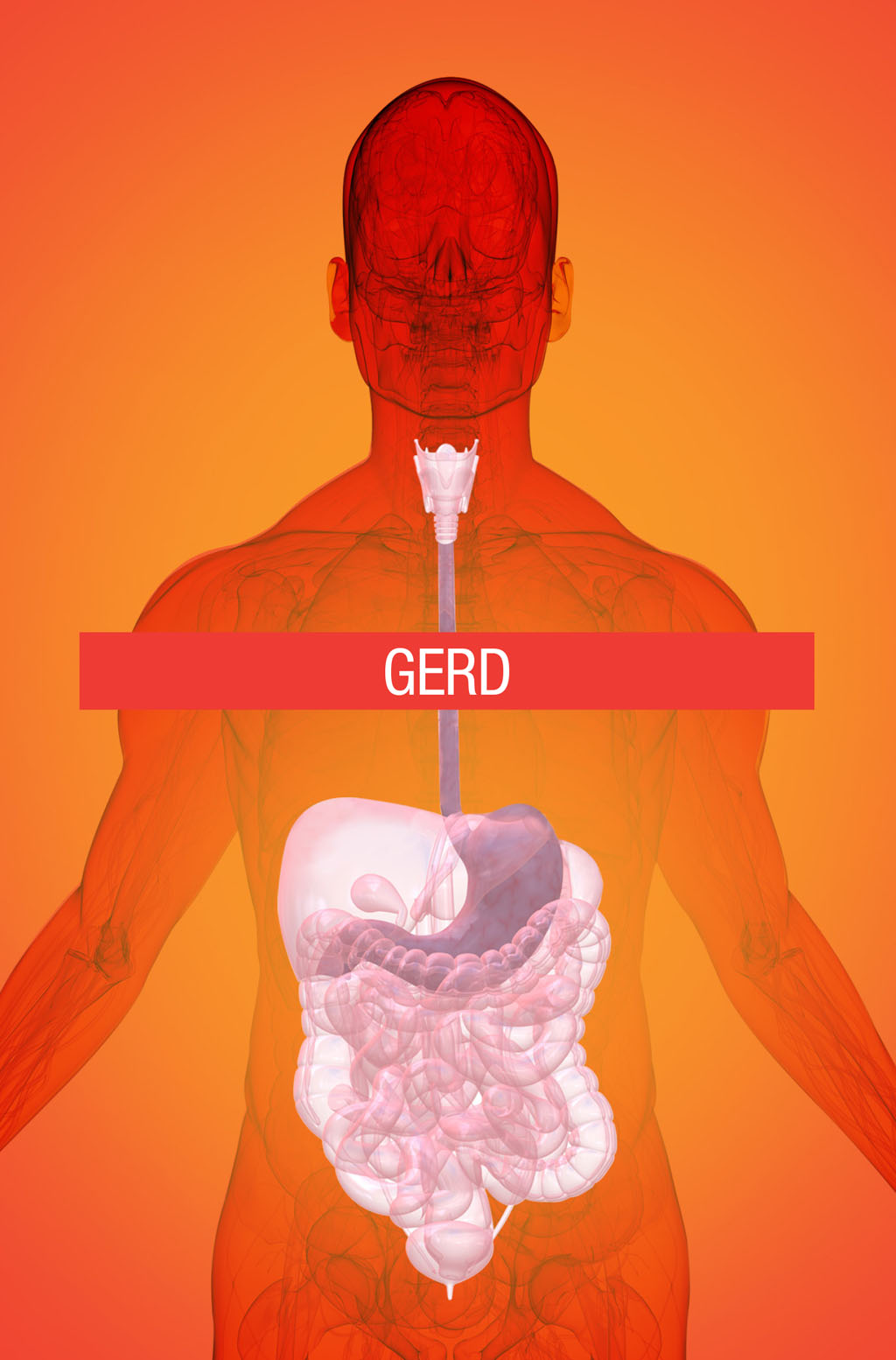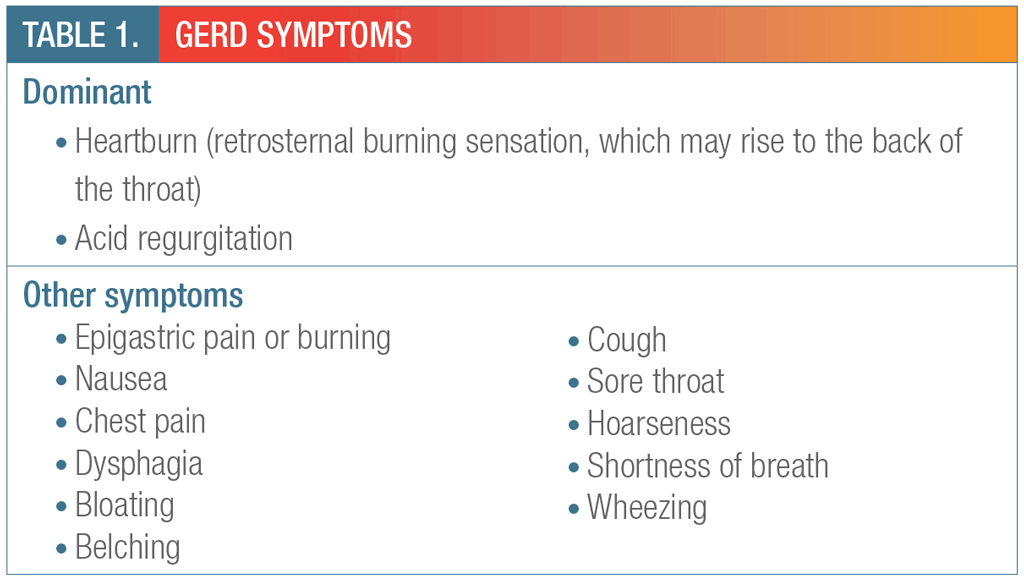GERD

GERD
Management of Gastroesophageal Reflux Disease in Adults
Adapted from: Armstrong D, Marshall JK, Chiba N, et al. for the Canadian Association of Gastroenterology GERD Consensus Group. Canadian consensus conference on the management of gastroesophageal reflux disease in adults – update 2004. Can J Gastroenterol 2004;19(1):15-35; American Gastroenterological Association Medical Position Statement on the Management of Gastroesophageal Reflux Disease. Gastroenterology 2008;135:1383-91.
OVERVIEW
Gastroesophageal reflux disease (GERD) is defined as a condition in which the reflux of gastric contents into the esophagus leads to troublesome symptoms, complications such as esophageal injury, or both. Its cardinal features include heartburn and acid regurgitation. Gastroesophageal reflux disease and related symptoms such as dyspepsia are common. One survey indicated that approximately 17% of Canadian adults had experienced heartburn in the preceding three months; 13% had moderate to severe symptoms at least weekly.1 Erosive esophagitis secondary to GERD has an estimated prevalence of 5 to 12%. In Canada, some $700 million is spent annually on therapy for GERD.
The severity of GERD is related to the degree and duration of esophageal acid exposure, which influences mucosal injury and severity of symptoms. In turn, symptoms can have a major impact on the patient's ability to perform normal daily activities and quality of life.
Gastroesophageal reflux disease may lead to significant complications, including Barrett's epithelium and dysplasia, which are risk factors for esophageal cancer. The risk of esophageal adenocarcinoma increases with the severity, frequency, and duration of GERD symptoms. The Canadian Association of Gastroenterology guidelines are designed to ensure dissemination of current knowledge on GERD in adult patients and to recommend evidence-based steps for appropriate management. The guidelines are drafted as statements on which a consensus panel voted. This summary presents key guiding principles that were strongly accepted and recommended by the panel.
KEY POINTS
KEY POINTS
- GERD may manifest with symptoms, esophageal injury, or both. Dominant symptoms are heartburn and acid regurgitation.
- Patients with GERD have a poorer health-related quality of life than those with diabetes, hypertension, or arthritis.
- GERD severity may be measured by the frequency, intensity, and duration of symptoms, the damage caused (esophageal erosion, ulceration, etc.), and its adverse effect on quality of life.
- Most patients with typical GERD symptoms do not require investigation (e.g., endoscopy). Suspected GERD may be treated empirically, provided there are no alarm features.
- Alarm features include vomiting, GI blood loss, anemia, involuntary weight loss, dysphagia, and chest pain.
- Endoscopy is indicated to investigate atypical or alarm features and to detect Barrett's epithelium.
- Initial therapy for GERD symptoms should be a 4- to 8-week course of a once-daily proton pump inhibitor (PPI).
- The majority of patients with moderate to severe GERD will experience relapse within 6 months, and will likely derive benefit from long-term treatment to limit gastric acid secretion.
- Therapy is aimed at symptom control, prevention of complications, and improving quality of life.
Definition
Definition
The diagnosis of GERD is based on a history of symptoms of heartburn and/or regurgitation sufficient to affect quality of life. Other symptoms of dyspepsia are also reported frequently, including epigastric pain or burning, or nausea (Table 1). Obesity and pregnancy are among the risk factors (Table 2).2
The term "heartburn-dominant uninvestigated dyspepsia" applies to patients who have reflux-like symptoms before they undergo investigation or receive therapy. A symptomatic response to treatment such as a course of proton pump inhibitor (PPI) therapy may help confirm the diagnosis.
In the majority of patients reporting GERD symptoms, further investigation (e.g., endoscopy) is not required; esophageal histology is not a component of diagnosis or a prerequisite for therapy. Up to 70% of patients with GERD symptoms have no endoscopic evidence of esophagitis.
An assessment of GERD severity takes into account the impact of symptoms on daily activities and health-related quality of life, which incorporates symptom frequency, intensity, and duration. Mild, infrequent heartburn that does not affect quality of life does not generally merit a diagnosis of GERD.
Mild GERD is defined as disease that causes low-intensity symptoms of short duration, fewer than 3 times per week, and has minimal effects on the patient's quality of life. Moderate or severe disease has more frequent, intense, or prolonged symptoms that significantly affect daily activities or quality of life. It may also involve reflux-related lesions such as erosions, ulceration, hemorrhage, strictures, or Barrett's epithelium.
Investigation
Investigation
As mentioned above, most patients with heartburn and acid reflux do not require investigation before treatment is initiated. Endoscopy is not immediately necessary in most cases, even in patients over age 50 (in whom the prevalence of esophageal cancer is increased). Similarly, testing for Helicobacter pylori infection is not needed before initiation of therapy.
However, prompt endoscopy or other investigations are generally recommended in a patient who exhibits any of the alarm features listed in Table 3. Endoscopy also allows detection of esophagitis (Table 4) and complications such as ulceration, strictures, Barrett's epithelium, or esophageal malignancy.
Dysphagia should be investigated if it does not completely resolve with an adequate course of PPI therapy. Solid-food dysphagia may suggest peptic stenosis, stricture, esophageal ring or web or malignancy. Cardiac causes for chest pain should be considered and investigated as appropriate.
Mucosal biopsies or follow-up endoscopies may be required to confirm Barrett's epithelium, detect dysplasia, investigate serious esophageal lesions, and/or to rule out conditions other than GERD.
Ambulatory pH monitoring may be employed to investigate symptoms that are atypical or continue despite appropriate GERD therapy.
Management
Management
Treatments that promote the suppression of gastric acid promote symptom relief and healing of esophagitis. Proton pump inhibitors are more effective and more cost-effective than H2 receptor antagonists (H2RAs) in achieving this goal. They resolve heartburn and esophagitis more rapidly and prevent symptomatic recurrence more effectively. Prokinetic or promotility agents are not recommended for initial treatment.
Initial therapy
Initial therapy
Over-the-counter medications including alginates, antacids, and low-dose H2RAs are safe and efficacious options for symptom control in patients with mild GERD (mild/infrequent symptoms). Lifestyle modifications may be effective in patients who know their symptoms have dietary or pharmacologic causes, or in those with obesity, smoking, or excessive alcohol use. Lifestyle measures and over-thecounter agents are not generally satisfactory therapy for patients with moderate to severe GERD.
Initial therapy for GERD symptoms should be a 4- to 8-week course of a once-daily PPI (unless symptoms occur fewer than 3 times/week and are mild). Twice-daily PPI may be appropriate for patients with suspected reflux chest pain syndrome. Table 5 lists the standard daily doses for the PPIs currently available. Clinicians should advise the patient to take the medication 30 to 60 minutes before the morning or evening meal.
In patients who receive clopidogrel for coronary event prevention, the use of PPIs should be restricted to those at significantly increased risk of GI bleeding or adverse events due to GERD or those in whom other acid-reducing strategies are ineffective. This recent recommendation is based on possible inhibition of clopidogrel effectiveness by PPIs.3 H. pylori infection need not be eradicated before initiation of PPI therapy. On the other hand, patients with known H. pylori infection should be offered eradication therapy.
The effect of medication on the patient's symptoms and quality of life should be assessed after the initial treatment course has been completed. At this point, endoscopy may be considered if the symptoms have not responded adequately or have worsened, or if new symptoms have developed. Alternatively, twice-daily administration of a standard-dose PPI may be used for patients whose symptoms are refractory to initial treatment.
Once the patient's GERD symptoms have responded to initial treatment, the PPI may be discontinued to determine whether symptoms recur and if there is a need for ongoing therapy.
Long-term therapy
Long-term therapy
About 75% of patients with endoscopically negative GERD and up to 100% with esophagitis will experience relapse within 6 months and will likely derive benefit from long-term treatment. The primary aim of long-term GERD therapy is to eliminate or control symptoms and improve the patient's health-related quality of life. Longer-term therapy for GERD may take the form of on-demand, intermittent, or continuous PPI administration, at the lowest dose and frequency possible for eliminating or reducing symptoms. The selection of therapy should take into account symptom control and patient preference.4
- On-demand therapy denotes the daily intake of medication until symptom resolution, following which treatment is stopped unless/until symptoms recur. On-demand therapy using a half or full dose of PPI is appropriate for selected patients (especially those without esophagitis).
- Intermittent therapy is the daily intake of medication for a set period (usually 2 to 8 weeks), initiated when GERD symptoms occur.
- Continuous therapy involves daily medication administration at the lowest possible dose to prevent or minimize recurrent reflux-related symptoms or esophageal injury.
Long-term gastric acid suppression has not been associated with clinically significant adverse events. Some patients may report diarrhea, abdominal pain, flatulence, headache, eructation, nausea, or rash.
Other therapies
Other therapies
Additional agents, such as prokinetic or promotility medications or supplementary H2RAs, are not generally recommended as part of long-term GERD therapy.
Surgical antireflux procedures may be considered instead of long-term medical therapy in selected patients. However, they have few advantages and may not eliminate the need for medication. Possible indications for surgery are regurgitation-dominant or volume-related reflux symptoms, dissatisfaction with long-term medical therapy, poor compliance, and the presence of a large hiatus hernia. It should be noted that a prior poor response to PPI therapy suggests that surgery may also be unsatisfactory.
Follow-up
Follow-up
Endoscopy to detect Barrett's epithelium with dysplasia may be considered in adults who have had GERD symptoms for more than 10 years. If endoscopy is performed to screen for Barrett's epithelium the patient should be taking antisecretory therapy, as it can be difficult to distinguish dysplasia from chronic inflammatory and regenerative changes caused by esophageal injury.
Those who have Barrett's epithelium without dysplasia may undergo repeat surveillance endoscopy (e.g., every 2 to 5 years). Individuals who have Barrett's epithelium and dysplasia should generally undergo periodic re-evaluation, including biopsy. In patients with low-grade dysplasia, a surveillance endoscopy with biopsy should be repeated within 12 months, and then repeated annually until there is no dysplasia detected. In patients with high-grade dysplasia, endoscopy and biopsy should be repeated within three months. In addition, specialist consultation can help establish optimal management strategies such as surgery or ablation.
CONCLUSION
CONCLUSION
Gastroesophageal reflux symptoms are highly prevalent and a frequent reason for patient visits to a primary care practitioner.5 Future updates to the GERD guidelines may provide more information on risk factors and prevention strategies, optimal treatment, and the impact of therapy on long-term complications.
References
References
- Tougas G, Chen Y, Hwang P et al. Prevalence and impact of upper gastrointestinal symptoms in the Canadian population. Findings from the DIGEST study. Am J Gastroenterol 1999;94:2845-54.
- British Columbia Medical Association/Ministry of Health Services. Guidelines and protocols advisory committee. Gastroesophageal reflux disease – clinical approach in adults. January 30, 2009. www.bcguidelines.ca/guideline_ gerd.html, accessed September 26, 2012.
- Sadowski D, Enns R, Moayyedi P. Proton pump inhibitors and clopidogrel – what is the current status? Canadian Association of Gastroenterology, April 2010. Accessed at www.cag-acg.org/uploads/ppisandclopidogrel_talking_ points_26april2010.pdf, September 2010.
- Morgan DG, O'Mahony MF, O'Mahony WF et al. Maintenance treatment of gastroesophageal reflux disease: An evaluation of continuous and on-demand therapy with rabeprazole 20 mg. Can J Gastroenterol 2007;212(12:)820-6.
- Liker H, Hungin P, Wiklund I. Managing gastroesophageal reflux disease in primary care: the patient perspective. J Am Board Fam Pract 2005;18(5):393-400.
Full guidelines
Full guidelines
The preceding material is a summary of the 2004 CAG guidelines on GERD. For details, clinicians are advised to consult the full guidelines: Armstrong D, Marshall JK, Chiba N, et al. for the Canadian Association of Gastroenterology GERD Consensus Group. Canadian consensus conference on the management of gastroesophageal reflux disease in adults – update 2004. Can J Gastroenterol 2004;19(1):15-35; and the AGA medical position statement on the management of gastroesophageal reflux disease. Gastroenterology 2008;135:1383-91.




